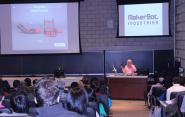The 3D-Printed Revolution

“We’re very proud of the way Yale is using our 3D printers,” said Jenny Lawton, president of MakerBot, during her Nov. 21 visit to Yale.
Though she was referring to the many uses Yale has found for MakerBot’s desktop 3D printing technology, she could have equally meant Yale’s many users: Of the 250 students attending Lawton’s lecture, nearly 100% raised their hands when asked who had experience using 3D printers.
Lawton, whose appearance was the latest event in the CEID Lecture Series, looked triumphant to see so many hands raised—veritable proof that, as she said at the beginning of her talk, “The next industrial revolution will be 3D printed.” She then presented a cornucopia of revolutionary technologies made with MakerBot Desktop 3D Printers, from a Robohand that can assist children born without fingers to a dress made entirely out of flexible filament.
However, Lawton noted that such a revolution won’t excite everyone; the expanding presence of 3D printers may force companies to change how they market to consumers. “This is a very, very, very disruptive technology,” said Lawton. “Consumer goods companies are going to really have to look at what they are. Your blender is missing its top? You can make one. And as such, it’s not about making stuff anymore, it’s about brand.”
But on the other hand, the same companies fretting about 3D printers in public hands are in turn discovering game-changing benefits from using the 3D printers themselves. Highlighting companies like Ford Motor Company, NASA, and special effects company Legacy Effects, Lawton showed how 3D printer adoption consistently speeds up the process from idea to production, while significantly reducing the costs of creating prototypes. And so more and more companies are buying 3D printers. According to Jack Heslin, MakerBot’s enterprise and key account executive, large companies like GE and Lockheed Martin are buying multiple 3D printers from MakerBot every month.
In fact, glancing around the room while Lawton engaged students in post-lecture conversation, Heslin summed up the promise of the night’s lecture: “If you’re using a 3D printer, put it on your resume.”

